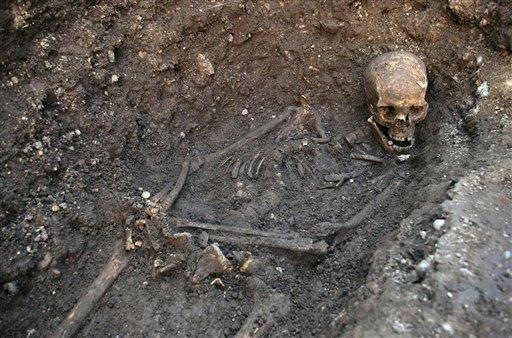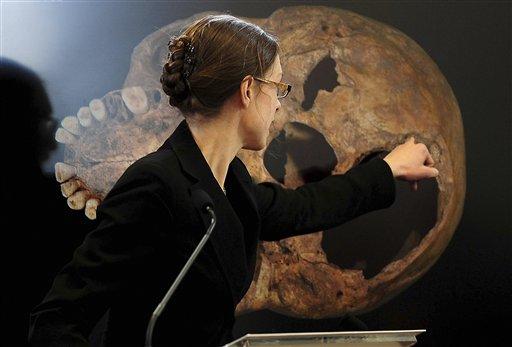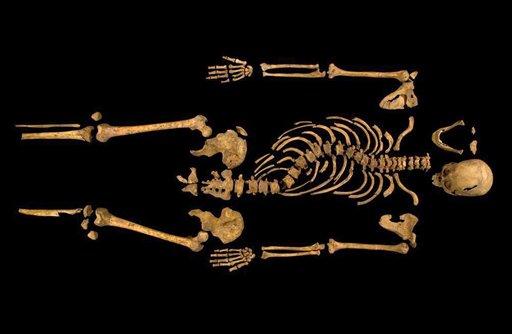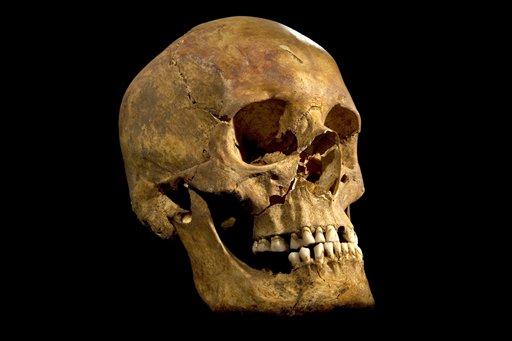University of Leicester / Photos University of Leicester
Source - http://phys.org/wire-news/121440048/university-of-leicester-announces-discovery-of-king-richard-iii.html

The University of Leicester today confirms (Monday, Feb. 4) that it has discovered the remains of King Richard III
UNIVERSITY OF LEICESTER REVEALS:
- Wealth of evidence, including radiocarbon dating, radiological evidence, DNA and bone analysis and archaeological results, confirms identity of last Plantagenet king who died over 500 years ago
- DNA from skeleton matches TWO of Richard III's maternal line relatives. Leicester genealogist verifies living relatives of Richard III's family
- Individual likely to have been killed by one of two fatal injuries to the skull – one possibly from a sword and one possibly from a halberd
- 10 wounds discovered on skeleton - Richard III killed by trauma to the back of the head. Part of the skull sliced off

- Radiocarbon dating reveals individual had a high protein diet – including significant amounts of seafood – meaning he was likely to be of high status
- Radiocarbon dating reveals individual died in the second half of the 15th or in the early 16th century – consistent with Richard's death in 1485
- Skeleton reveals severe scoliosis – onset believed to have occurred at the time of puberty

- Although around 5 feet 8 inches tall (1.72m), condition meant King Richard III would have stood significantly shorter and his right shoulder may have been higher than the left
- Feet were truncated at an unknown point in the past, but a significant time after the burial
- Corpse was subjected to 'humiliation injuries' –including a sword through the right buttock
- Individual had unusually slender, almost feminine, build for a man – in keeping with contemporaneous accounts
- No evidence for 'withered arm' –as portrayed by Shakespeare – found
- Possibility that the individual's hands were tied
- Grave was hastily dug, was not big enough and there was no shroud or coffin
At a specially convened media conference, experts from across the University unanimously identified the remains discovered in Leicester city centre as being those of the last Plantagenet king who died in 1485.
Rigorous scientific investigations confirmed the strong circumstantial evidence that the skeleton found at the site of the Grey Friars church in Leicester was indeed that of King Richard III.
University of Leicester researchers have revealed a wealth of evidence – including DNA analysis, radiocarbon dating and skeletal examination - proving the identity of the skeleton.
University of Leicester archaeologists co-director Richard Buckley, the lead archaeologist on the Search for Richard III, said: "It is the academic conclusion of the University of Leicester that the individual exhumed at Grey Friars in August 2012 is indeed King Richard III, the last Plantagenet King of England.

"It has been an honour and privilege for all of us to be at the centre of an academic project that has had such phenomenal global interest and mass public appeal. Rarely have the conclusions of academic research been so eagerly awaited."
University of Leicester geneticist Dr Turi King confirmed that DNA from the skeleton matches that of two of Richard III's family descendants – Canadian-born furniture maker Michael Ibsen and a second person who wishes to remain anonymous.
Dr King, of the University's Department of Genetics, said: "The DNA sequence obtained from the Grey Friars skeletal remains was compared with the two maternal line relatives of Richard III. We were very excited to find that there is a DNA match between the maternal DNA from the family of Richard the Third and the skeletal remains we found at the Grey Friars dig."
Skeletal analysis carried out by University of Leicester osteoarchaeologist Dr Jo Appleby showed that the individual was male and in his late 20s to late 30s. Richard III was 32 when he was killed at the Battle of Bosworth in 1485.
The individual had a slender physique and severe scoliosis – a curvature of the spine – possibly with one shoulder visibly higher than the other. This is consistent with descriptions of Richard III's appearance from the time.
Trauma to the skeleton indicates the individual died after one of two significant wounds to the back of the skull – possibly caused by a sword and a halberd.
This is consistent with contemporary accounts of Richard being killed after receiving a blow to the back of his head.
The skeleton also showed a number of non-fatal injuries to the head, rib and pelvis – believed to have been caused by a wound through the right buttock – which may have been caused by 'humiliation injuries' after death.
Dr Appleby's analysis is backed up by radiological evidence carried out by University of Leicester forensic pathologists and forensic engineering experts.
Dr Appleby, of the University's School of Archaeology and Ancient History, said: "The skeleton has a number of unusual features: its slender build, the scoliosis and the battle-related trauma. All of these are highly consistent with the information that we have about Richard III in life and about the circumstances of his death. Taken as a whole, the skeletal evidence provides a highly convincing case for identification as Richard III."
The verdict also drew from circumstantial evidence at the dig site, radiocarbon dating, genealogical evidence and comparison with historical sources.
The University of Leicester, in association with Leicester City Council and the Richard III Society, led the Search for Richard III.
The Search for Richard III is also the subject of a Channel 4 documentary made by Darlow Smithson Productions.
The documentary makers had exclusive access to the search team during the archaeological dig and during the scientific tests to determine the skeleton's identity.
Evidence from DNA analysis
University of Leicester geneticist Dr Turi King found a match between DNA from the skeleton and two direct descendents of Richard III on the female line.
The modern DNA work was carried out by Dr Turi King at the University of Leicester. Dr Turi King carried out the ancient DNA analysis in dedicated ancient DNA facilities at the University of York, in the lab of Professor Michael Hofreiter with Gloria Gonzales Fortes, and travelled to the Université Paul Sabatier in Toulouse to work with Dr Patricia Balaresque and Laure Tonasso and where the work was independently verified.
This was checked with mitochondrial DNA from the two female-line descendents - Canadian-born furniture maker Michael Ibsen and a second person who wishes to remain anonymous.
Their link with Richard III was verified by a genealogical study led by University Pro-Vice-Chancellor Professor Kevin Schürer.
Dr Turi King said: "The aim of our part of the project is to use DNA evidence to help identify the skeletal remains found at the Grey Friars site: does the DNA analysis corroborate the archaeological evidence and point to these being the remains of Richard III?
"The first step was to determine if the two female line relatives – Michael Ibsen and a second person who wishes to remain anonymous - shared the same mitochondrial DNA sequences. The analysis showed that these two individuals shared the same relatively rare mitochondrial DNA sequence.
"We then had to see if it was even possible to retrieve ancient DNA from the Grey Friars skeleton. DNA breaks down over time and how quickly this happens is very dependent on the burial conditions. Therefore, we were extremely pleased to find that we could obtain a DNA sample from the skeletal remains.
"Finally, the DNA sequence obtained from the Grey Friars skeletal remains was compared with the two maternal line relatives of Richard III. We were very excited to find that there is a DNA match between the maternal DNA from the family of Richard the Third and the skeletal remains we found at the Grey Friars dig.
"Like a forensic case, the DNA evidence must be assessed alongside the other evidence. Here the results of the archaeological and osteological analysis, combined with the genealogical and genetic evidence make for a strong and compelling case that these are indeed the remains of Richard III.
In addition, the researchers are hoping to compare the skeleton's DNA with descendents down the male line.
To do this, they will need to obtain Y chromosome data – the male sex chromosome. Preliminary analysis of the DNA confirmed that these are indeed the remains of a male and so researchers are hopeful that they will be able to analyse the Y chromosome.
"A number of the men identified as descendents of Edward III through his son John of Gaunt - who would both have shared the same Y chromosome as Richard III - have been kind enough to donate their DNA to our project.
"The analysis of their DNA is complete and I now have a consensus Y chromosome type of these individuals.
"As such, this side of the work is in its early stages, and may indeed prove inconclusive, but we are hopeful that, if it's possible to conduct a full analysis, it will provide a complete picture on both the male and female lines."
PART.2